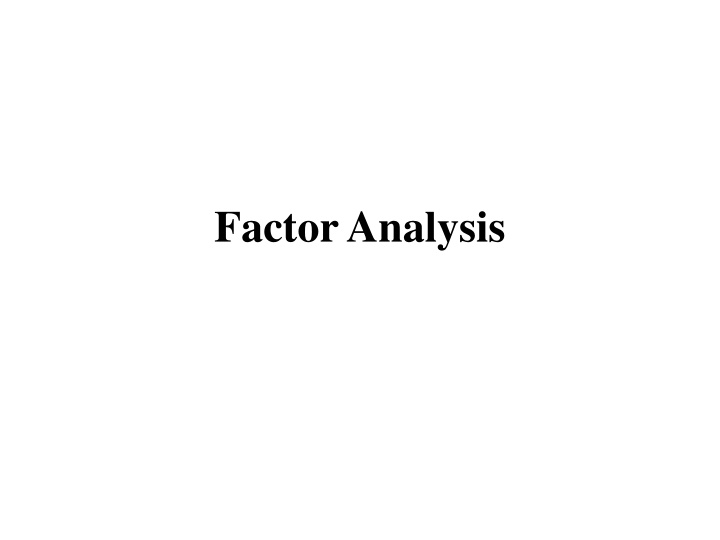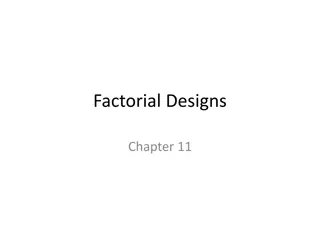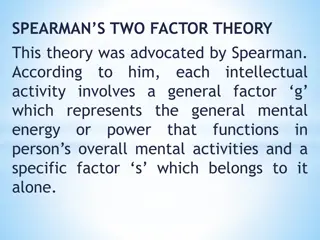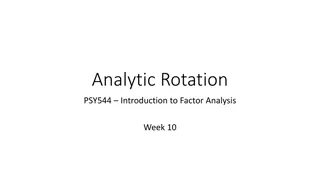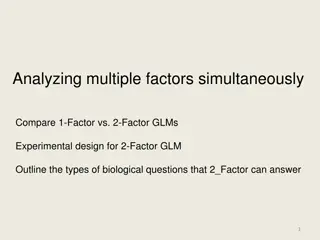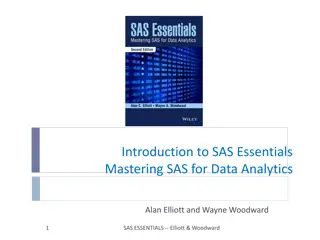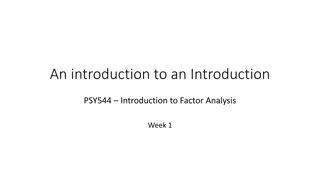Factor Analysis
Factor Analysis (FA) is an advanced statistical method to identify relationships among variables, reduce data complexity, and derive underlying factors. This analysis helps in data reduction, latent factor determination, and understanding correlations within a dataset. Explore the essential features, applications, and steps involved in FA to enhance your research and decision-making processes.
Download Presentation

Please find below an Image/Link to download the presentation.
The content on the website is provided AS IS for your information and personal use only. It may not be sold, licensed, or shared on other websites without obtaining consent from the author.If you encounter any issues during the download, it is possible that the publisher has removed the file from their server.
You are allowed to download the files provided on this website for personal or commercial use, subject to the condition that they are used lawfully. All files are the property of their respective owners.
The content on the website is provided AS IS for your information and personal use only. It may not be sold, licensed, or shared on other websites without obtaining consent from the author.
E N D
Presentation Transcript
Definition FA is an advanced form of correlation analysis applied to responses of a large number of persons or statements to identify the items that are similar. Principal component analysis ( Prof. H. Hotelling) is an empirical technique of breaking down a correlation or covariance matrix into a set of orthogonal components. Or over Centroid instrument. advanced method
Essential Features A multivariate technique Output as factors Basis of selection of a variables. A measure of correlation Applied to continuous variables. Based on 3 measures(mean variation, standardized scores and coefficient of correlation) Attempt to find best. Assumptions of linear relationship.
Application of FA Reduction in the no. of variables. Determination of latent factors Determination of latent relationship. Determination of grouping of factors. Determination of cluster of observations. Composite indicators Determination of consumer preferences
What is Factor Analysis (FA)? FA and PCA (principal components analysis) are methods of data reduction Take many variables and explain them with a few factors or components Correlated variables are grouped together and separated from other variables with low or no correlation
What is FA? Patterns of correlations are identified and either used as descriptives (PCA) or as indicative of underlying theory (FA) Process of providing an operational definition for latent construct (through regression equation)
What is FA? FA and PCA are not much different than canonical correlation in terms of generating canonical variates from linear combinations of variables Although there are now no sides of the equation And your not necessarily correlating the factors , components , variates , etc.
General Steps to FA Step 1: Selecting and Measuring a set of variables in a given domain Step 2: Data screening in order to prepare the correlation matrix Step 3: Factor Extraction Step 4: Factor Rotation to increase interpretability Step 5: Interpretation Further Steps: Validation and Reliability of the measures
Good Factor A good factor: Makes sense will be easy to interpret simple structure Lacks complex loadings
Problems w/ FA Unlike many of the analyses so far there is no statistical criterion to compare the linear combination to In MANOVA we create linear combinations that maximally differentiate groups In Canonical correlation one linear combination is used to correlate with another
Problems w/ FA It is more art than science There are a number of extraction methods (PCA, FA, etc.) There are a number of rotation methods (Orthogonal, Oblique) Number of factors to extract Communality estimates ETC This is what makes it great
Problems w/ FA Life (researcher) saver Often when nothing else can be salvaged from research a FA or PCA will be conducted
Types of FA Exploratory FA Summarizing data by grouping correlated variables Investigating sets of measured variables related to theoretical constructs Usually done near the onset of research The type of FA and PCA we are talking about in this chapter
Types of FA Confirmatory FA More advanced technique When factor structure is known or at least theorized Testing generalization of factor structure to new data, etc. This is tested through SEM methods discussed in the next chapter
Terminology Factor: A factor is weighted linear combination of the variables under study. Factor Loading: These are the values indicating the extent of closeness of relationship among variables constituting factors. Factor score: Coefficient of the factors Observed Correlation Matrix Reproduced Correlation Matrix Residual Correlation Matrix
Commonality(H2): It indicates the extent a variable has been accounted for by underlying factor taken together. Higher C, Higher the variables has been considered. Eigen value: The sum of squares of factor loading relating to a factor is known as Eigen value. Total sum squares: The total of Eigen values of all the factors extracted is known as total sum squares. Factor Rotation: It is done to reveal different structures in the data.
Terminology Orthogonal Rotation Loading Matrix correlation between each variable and the factor Oblique Rotation Factor Correlation Matrix correlation between the factors Structure Matrix correlation between factors and variables Pattern Matrix unique relationship between each factor and variable uncontaminated by overlap between the factors
Terminology Factor Coefficient matrix coefficients used to calculate factor scores (like regression coefficients)
FA vs. PCA conceptually FA produces factors; PCA produces components Factors cause variables; components are aggregates of the variables. PCA: It is a linear combination of variables contributing maximum total variance.
Conceptual FA and PCA FA PCA I1 I2 I3 I1 I2 I3
FA vs. PCA conceptually FA analyzes only the variance shared among the variables (common variance without error or unique variance); PCA analyzes all of the variance FA: What are the underlying processes that could produce these correlations? ; PCA: Just summarize empirical associations, very data driven
Questions Three general goals: data reduction, describe relationships and test theories about relationships (next chapter) How many interpretable factors exist in the data? or How many factors are needed to summarize the pattern of correlations?
Questions What does each factor mean? Interpretation? What is the percentage of variance in the data accounted for by the factors?
Questions Which factors account for the most variance? How well does the factor structure fit a given theory? What would each subject s score be if they could be measured directly on the factors?
Considerations (from Comrey and Lee, 1992) Hypotheses about factors believed to underlie a domain Should have 6 or more for stable solution Include marker variables Pure variables correlated with only one factor They define the factor clearly Complex variables load on more than on factor and muddy the water
Considerations (from Comrey and Lee, 1992) Make sure the sample chosen is spread out on possible scores on the variables and the factors being measured Factors are known to change across samples and time points, so samples should be tested before being pooled together
